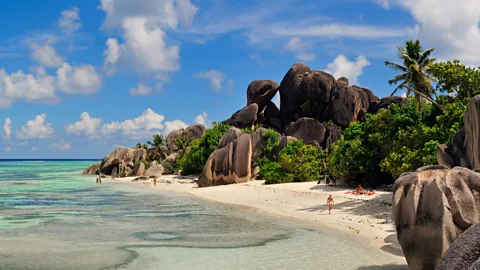La Digue: The Seychelles' tropical biking paradise
 Anders Blomqvist/Getty Images
Anders Blomqvist/Getty ImagesThere are more bicycles than cars on La Digue, a 10-sq-km island that is doing everything it can to save itself – and one rare bird species – from overtourism.
La Digue is arguably one of the most well-known of the 115 islands in the Seychelles. It attracts thousands of tourists each year to Anse Source d'Argent, often called the most photographed beach in the world due to its imposing boulders reminiscent of prehistoric times, an ideal backdrop to Hollywood films and commercials. On a smaller scale, bird watchers from all over come to witness the rare sighting of the Seychelles Black Paradise Flycatcher bird, an endangered species endemic to the Seychelles.
But perhaps the island's less well-known marvel is its lack of cars, and how the Digueois have managed to limit traffic in order to protect the pristine beauty of their 10 sq km territory.
With a population of only about 3,000, the Digueois pride themselves on using the bicycle as their main form of transport, unlike the bigger neighbouring islands of Mahé and Praslin, which have seen more urban growth. For locals, a car is unnecessary and moving with bicycles has always been a way of life.
"From a small age, my brother used to try and teach us how to ride the bike. They hold the seat and you're thinking they are holding, then let you go and then you fall, and you lose your knees. And that's how you learn to ride a bike," said Florie Marie, a La Digue resident." Still, my sister, she lives in Mahé, and she still doesn't know how to ride a bike."
Tourists also partake in the local tradition, renting bikes to explore the island. "La Digue is known to be a bicycle island. So, you will get clients wanting to travel by car to the beach, but the majority, they want bicycles," said Travis Mills, who owns a bicycle-rental company on La Digue.
The island's current vehicle count is 60, a sizable increase from the 10 it had in the '80s when only wealthy families could afford to own cars. But it's still a small number, one that is partly tied to the difficulties of individual vehicle ownership here: no cars are allowed unless they provide a public service. However, the rise in tourism construction and the necessary vehicles that come with that work has set alarm bells ringing, especially with locals.
"With more vehicles on La Digue, that aspect of tranquillity, quietness, relaxedness will no longer be there. And that will definitely have a great impact on La Digue itself, its tourism, its environment, and its ecosystem," said Patrick Andre, the Seychelles' Principal Secretary of Transport.
Conservationists caution that further development could impact the natural habitat of endangered species on the island, such as the Seychelles Black Paradise Flycatcher, known as the Vev in local Creole. The Veuve Reserve, a national park and conservation area set up to protect the endemic Vev, is a crowning jewel of natural beauty for the Digueois.
 Atlantide Phototravel/Getty Images
Atlantide Phototravel/Getty Images"We have seen the increase in the numbers of construction or development on the island of La Digue, and this has been a big concern regarding the population of the flycatcher," said Josianna Rose, a park ranger at the Veuve Reserve. "People from La Digue are building quite a lot, they are cutting down trees for construction."
Since 2008, conservationists have transported a few dozen flycatchers to neighbouring islands through a breeding programme that would ensure this rare bird species has additional suitable habitats.
La Digue has now placed a moratorium on building new tourism establishments until 2023, in an effort to preserve the local natural resources. "If we really want La Digue to remain one of the gems of Seychelles, we have to be able to, at this point, start controlling, monitoring development on the island," said Sherin Francis, Chief Executive of the Seychelles Tourism Board.
Similarly, the ban of private vehicle ownership, as well as discussions on phasing out all fuel-dependent vehicles and expanding more traditional forms of transport (there's only one ox-cart operator left on the island), have become part of the goal to turn La Digue into the eco-capital of Seychelles.
---
Join more than three million BBC Travel fans by liking us on Facebook, or follow us on Twitter and Instagram.
If you liked this story, sign up for the weekly bbc.com features newsletter called "The Essential List". A handpicked selection of stories from BBC Future, Culture, Worklife and Travel, delivered to your inbox every Friday.
